Source: Journal of Geophysical Research: Biogeosciences
Permanently frozen soil and rock known as permafrost are a familiar feature in cold climates on land. However, permafrost also exists below the seafloor.
Submarine permafrost initially forms on land but is then covered by rising seas. Much of the subsea permafrost that exists today slipped beneath the ocean 7,000 to 15,000 years ago after the last ice age ended, but some is more recent. It now persists in the Arctic Ocean on continental shelves and is home to microbial communities that are poorly understood.

To learn more about these microbes, Mitzscherling et al. examined two permafrost cores from the East Siberian Arctic Shelf beneath the Laptev Sea. One core represented permafrost that was submerged 2,500 years ago, whereas the other was inundated just 540 years ago.
The researchers compared the cores to investigate how microbial communities in submarine permafrost change over time. They analyzed the chemistry of water trapped in pores in the permafrost, counted microbial cells, and used genetic information, including 16S ribosomal RNA deep sequencing, to determine the kinds of bacteria present in each core.
The results suggest that ocean inundation initially disrupts and decreases the size of the terrestrial microbial communities in permafrost. This is likely a result of increased pore water salinity as well as of warming due to increased heat transfer in the ocean and the lower freezing point of salt water.
Despite this initial disruption, the analysis suggests that warmer submarine conditions later stimulate microbial growth. Although the structure and diversity of these communities change to reflect the new environment, the bacterial species remain terrestrial; in other words, they are not replaced with marine species.
Over time, warmer submarine conditions slowly thaw the permafrost. The researchers found that pore water chemistry at different permafrost depths reflects different stages of thaw. However, pore water analyses also revealed that pore water chemistry begins to change in frozen submarine permafrost even before it thaws.
Genetic analysis provided evidence that bacteria eventually separate into different communities with different species composition depending on depth and degree of thawing. The still-frozen permafrost in the core that flooded 2,500 years ago held the highest numbers of bacteria, suggesting that microbial communities in submarine permafrost may thrive thousands of years after inundation.
Further research will be needed to clarify and build on these findings. For instance, some of the differences in microbial community composition between the two cores could be due to different inundation processes, or they could be due to different source locations and unique postinundation history and sedimentation. Additional work could help tease out these factors.
Understanding subsea permafrost’s microbial communities could help researchers learn how permafrost will behave if future sea level rise inundates more land in the Arctic. The authors note that determining this behavior is important because microbes play a role in freeing greenhouse gases from permafrost, which is a known carbon sink. (Journal of Geophysical Research: Biogeosciences, https://doi.org/10.1002/2017JG003859, 2017)
—Sarah Stanley, Freelance Writer
Citation:
Stanley, S. (2017), Microbes may thrive in subsea permafrost long after flooding, Eos, 98, https://doi.org/10.1029/2017EO080655. Published on 01 September 2017.
Text © 2017. The authors. CC BY-NC-ND 3.0
Except where otherwise noted, images are subject to copyright. Any reuse without express permission from the copyright owner is prohibited.

